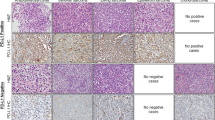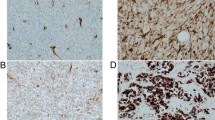Abstract
Programmed death-1 (PD-1) and programmed death-ligand 1 (PD-L1) are new targets in cancer immunotherapy in recent years. The aim of this study is to evaluate the PD-1/PD-L1 expressions in sarcomas and to determine association between PD-1/PD-L1 expressions and clinical/pathological properties in some sarcoma subtypes. Formalin-fixed, paraffin-embedded tissue samples from 65 cases with sarcomas were analyzed. Immunohistochemical staining was performed to detect the PD-1 and PD-L1 expressions in tumor tissue and microenvironment, separately. PD-1 expression in tumor tissue and microenvironment was detected in 11 (17 %) and 8 (12 %) cases, respectively. PD-L1 expression in tumor tissue and microenvironment was detected in 19 (29 %) and 20 cases (30 %), respectively. None of the 5 Ewing sarcomas involving bone showed PD-1/PD-L1 expression, while 2 of 3 cases with Ewing sarcomas involving soft tissue showed PD-1 and PD-L1 expression. Among 5 cases with Kaposi sarcoma, four showed PD-1 and/or PD-L1 expression in tumor or microenvironment. PD-1/PD-L1 expressions were detected 3 of 6 cases with pleomorphic sarcoma, 2 of 4 cases with peripheral nerve sheath tumors and 1 of 4 cases with synovial sarcoma. Interestingly, strongest PD-1/PD-L1 expressions in our study group were detected in 2 sarcoma cases with the history of giant cell tumor. PD-1 and PD-L1 expressions are up to 30 % of the cases with sarcomas. It may be rational to target programmed death pathway in Kaposi sarcoma, pleomorphic sarcoma and peripheral nerve sheath tumors. Strong expression of PD-1/PD-L1 in cases with previous giant cell bone tumor has been found to be interesting and must be studied in giant cell tumor samples.

Similar content being viewed by others
References
Naidoo J, Page DB, Wolchok JD. Immune modulation for cancer therapy. Br J Cancer. 2014;111:2214–9.
Ravetch JV, Lanier LL. Immune inhibitory receptors. Science. 2000;290:84–9.
Zheng H, Liu X, Zhang J, Rice SJ, Wagman M, Kong Y, Zhu L, Zhu J, Joshi M, Belani CP. Expression of PD-1 on CD4+ T cells in peripheral blood associates with poor clinical outcome in non-small cell lung cancer. Oncotarget. 2016. doi:10.18632/oncotarget.9316.
Dong L, Lv H, Li W, Song Z, Li L, Zhou S, Qui L, Qian Z, Liu X, Feng L, Meng B, Fu K, Wang X, Pan-Hammarström Q, Wang P, Wang X, Zhang H. Co-expression of PD-L1 and p-AKT is associated with poor prognosis in diffuse large B cell lymphoma via PD-1/PD-L1 axis activating intracellular AKT/m TOR pathway in tumor cells. Oncotarget. 2016. doi:10.18632/oncotarget.9061.
Chen K, Chen G, Zhang F, Zhang N, Li D, Jin J, Wu J, Ying L, Mao W, Su D. Prognostic significance of programmed death-1 and programmed death-ligand 1 expression in patients with esophageal squamous cell carcinoma. Oncotarget. 2016. doi:10.18632/oncotarget.8956.
Webb JR, Milne K, Kroeger DR, Nelson BH. PD-L1 expression is associated with tumor-infiltrating T cells and favorable prognosis in high-grade serous ovarian cancer. Gynecol Oncol. 2016;141:293–302.
Paydas S, Bağır E, Seydaoglu G, Ercolak V, Ergin M. Programmed death-1 (PD-1), programmed death-ligand 1 (PD-L1), and EBV-encoded RNA (EBER) expression in Hodgkin lymphoma. Ann Hematol. 2015;94:1545–52.
Burgess M, Gorantla V, Weis K, Tawbi H. Immunotherapy in sarcoma: future horizons. Curr Oncol Rep. 2015;17:52.
Coley WB. II. Contribution to the knowledge of sarcoma. Ann Surg. 1891;14:199–220.
Zheng J, Zhang XK, Chen HD, Zhong ZH, Wu QL, Lin SX. Expression of programmed cell death-ligand 1 and its correlation with clinical outcomes in gliomas. Oncotarget. 2016;7(8):8944–55. doi:10.18632/oncotarget.6884.
Koh YW, Jeon YK, Yoon DH, Suh C, Huh J. Programmed death 1 expression in the peritumoral microenvironment is associated with a poorer prognosis in classical Hodgkin lymphoma. Tumour Biol. 2016;37:7507–14.
Zhang L, Qiu M, Jin J, Li B, Wang X, Yan S, Xu R, Yang D. Programmed cell death ligand 1 (P-L1) expression on gastric cancer and its relationship with clinicopathologic factors. Int J Clin Exp Pathol. 2015;8:11084–91.
Barrett MT, Anderson KS, Lenkiewicz E, Andreozzi M, Cunliffe HE, Klassen CL, Dueck AC, McCullough AE, Reddy SK, Ramanathan RK, Northfelt DW, Pockaj BA. Genomic amplification of 9p24.1 targeting JAK2, PD-L1 and PD-L2 is enriched in high-risk triple negative breast cancer. Oncotarget. 2015;6(28):26483–93. doi:10.18632/oncotarget.4494.
Schmidt LH, Kümmel A, Görlich D, Mohr M, Bröckling S, Mikesch JH, Grünewald I, Marra A, Schultheis AM, Wardelmann E, Müller-Tidow C, Spieker T, Schliemann C, Berdel WE, Wiewrodt R, Hartmann W. PD-1 and PD-L1 expression in NSCLC indicate a favorable prognosis in defined subgroups. PLoS One. 2015;10(8):e0136023.
Wu P, Wu D, Li L, Chai Y, Huang J. PD-L1 and survival in solid tumors: a meta-analysis. PLoS One. 2015;10(6):e0131403. doi:10.1371/journal.pone.0131403.
Movva S, Wen W, Chen W, Millis SZ, Gatalica Z, Reddy S, von Mehren M, Tine BAV. Multi-platform profiling of over 2000 sarcomas: identification of biomarkers and novel therapeutic targets. Oncotarget. 2015;6:12234–47.
Kim JR, Moon YJ, Kwon KS, Bae JS, Wagle S, Kim KM, Park HS, Lee H, Moon WS, Chung MJ, Kang MJ, Jang KY. Tumor infiltrating PD-1-positive lymphocytes and the expression of PD-L1 predict poor prognosis of soft tissue sarcomas. PLoS One. 2013;8(12):e82870. doi:10.1371/journal.pone.0082870.
D’Angelo SP, Shoushtari AN, Agaram NP, Kuk D, Qin LX, Carvajal RD, Dickson MA, Gounder M, Keohan ML, Schwartz GK, Tap WD. Prevalence of tumor-infiltrating lymphocytes and PD-L1 expression in the soft tissue sarcoma microenvironment. Hum Pathol. 2015;46:357–65.
Shen JK, Cote GM, Choy E, Yang P, Harmon D, Schwab J, Nielsen GP, Chebib I, Ferrone S, Wang X, Wang Y, Mankin H, Hornicek FJ, Duan Z. Programmed cell death ligand 1 expression in osteosarcoma. Cancer Immunol Res. 2014;2:690–8.
Zheng W, Xiao H, Liu H, Zhou Y. Expression of programmed death 1 is correlated with progression of osteosarcoma. APMIS. 2014;123:102–7.
Mesri EA, Cesarman E, Boshoff C. Kaposi’s sarcoma and its associated herpesvirus. Nat Rev Cancer. 2010;10:707–19.
Ledergerber B, Telenti A, Egger M. Risk of HIV related Kaposi’s sarcoma and non-Hodgkin’s lymphoma with antiretroviral therapy: prospective cohort study. BMJ. 1999;31:23–4.
Kim S, Kim MY, Koh J, Go H, Lee DS, Jeon YK, Chung DH. Programmed death-1 ligand 1 and 2 are highly expressed in pleomorphic carcinomas of the lung: comparison od sarcomatous and carcinomatous areas. Eur J Cancer. 2015;51:2698–707.
Velcheti V, Rimm DL, Schalper KA. Sarcomatoid lung carcinomas Show high levels of programmed deat ligand-1 (PD-L1). J Thorac Oncol. 2013;8:803–5.
Acknowledgments
This study has been supported by Cukurova University Research Fund.
Author information
Authors and Affiliations
Corresponding author
Ethics declarations
Conflict of interest
None.
Additional information
This study has been submitted to ESMO 2016 meeting.
Rights and permissions
About this article
Cite this article
Paydas, S., Bagir, E.K., Deveci, M.A. et al. Clinical and prognostic significance of PD-1 and PD-L1 expression in sarcomas. Med Oncol 33, 93 (2016). https://doi.org/10.1007/s12032-016-0807-z
Received:
Accepted:
Published:
DOI: https://doi.org/10.1007/s12032-016-0807-z




